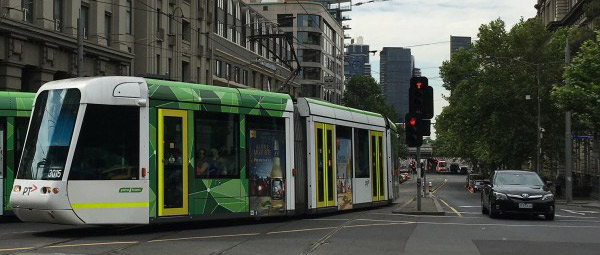
VicRoads
VicRoads plans, develops and manages the arterial road network and delivers road safety initiatives and customer-focused registration and licensing services. The key role of VicRoads is to help provide Victorians with safe and easy connections to the people and places that matter most to them.
VicRoads is now part of the Department of Transport, providing an integrated state transport department.
ACEMS collaborates with VicRoads to address cutting edge traffic modelling technologies as well as operations research and other methodological approaches.

In 2022, ACEMS researchers extended their engagements and collaborations with VicRoads and across the wider Victorian Department of Transport (DoT), of which VicRoads is now part.
Department of Transport Optimisation and Macroscopic Fundamental Diagrams (MFDs)
The DoT’s Network Optimisation area was interested in learning about applications for research conducted by ACEMS researchers CI Tim Garoni, CI Jan de Gier and AI Joyce Zhang, as featured in their published journal article “A comparative study of Macroscopic Fundamental Diagrams of arterial road networks governed by adaptive traffic signal systems”.

Ideas Challenge Ideas and Project
Both ACEMS researchers and VicRoads/DoT engaged with the ACEMS Ideas Challenge opportunity, and various ideas were put forward for projects.
Ultimately, the Ideas Challenge supported a new project titled “Study into Arterial Network Optimisation - including consideration of Macroscopic Fundamental Diagrams”. Other opportunities considered and may be pursued later included work on: Hierarchical perimeter control; Dynamic public transport scheduling; Traffic congestion prediction; Travel time estimation and parameter estimation.

ACEMS Support for New Research Outputs from Co-funded Research
ACEMS Samithree Rajapaksha was awarded her PhD, co-funded by VicRoads and ACEMS, in May 2021. A number of the research questions in her PhD were directly motivated to help industry through conversations with ACEMS Partner VicRoads.
These topics of interest to transport including VicRoads were:
- modelling the travel time distribution of vehicles along a stretch of road joining two sets of traffic signals, considering the effects of varying signal parameters such as offset and green split;
- Samithree's numerical results suggest that travel time distributions can be well described by a Gaussian mixture model, where the number of components in the mixture corresponds approximately to the random number of cycles vehicles wait at the downstream;
- an analytical method to predict some of the parameters characterising the Gaussian mixture based on a deterministic domain-wall model; and
- the parameter predictions agree well with the numerical results.
- calibrating traffic models using Approximate Bayesian Computation
- This work involved calibrating a small portion of a traffic model based on generalisations of the asymmetric exclusion process.
In order to increase the outputs from this research, ACEMS awarded Research Sprint Scheme funds to support the conversion of key chapters in Dr Rajapaksha’s thesis into research papers for submission to appropriate academic journals, including in statistical mechanics and in traffic engineering.
Strategic Meeting: ACEMS and Leaders Across Department of Transport
In late October, VicRoads and ACEMS organised and hosted a strategic meeting for leaders from key business areas across the Victorian Department of Transport to meet with key researchers from ACEMS.
The aim of the meeting was to increase connections across the organisations, including for future engagements and collaborations, hear presentations on key work of DoT, provide a forum for discussion of this work, provide an overview of how researchers at ACEMS (including its University of Melbourne and Monash nodes particularly) have collaborated with VicRoads historically and may in the future, including beyond ACEMS.
There were three main presentations at this meeting including:
- Road Optimisation
- Presented by Fiona Culvert – Director, Transport Reform
- Fiona leads and coordinates policies for reform of the transport system in the Department of Transport in Victoria. She is leading and coordinating efforts across the department to find new ways to address the impacts of congestion and reduce travel times and delays in the road network. She is leading Department of Transport consideration of the emerging advanced aerial mobility industry and supports policy development and reform for a wide range of other issues.
- Managed motorways and freeways
- Presented by Matthew Hall – Manager, Managed Motorways/Network Optimisation
- Matthew is a technical leader in the field of traffic engineering, with extensive experience in developing, designing and reviewing improvement projects aimed at optimising the efficiency and safety of on-road operations. He is heavily involved in the design and development of urban motorways (new and upgraded facilities), across all stages of design and operations, and the ongoing improvement of operational control of motorways to optimise productivity and safety.
- Modelling and analytics
- Presented by Roberto Evangelio – Director, Transport Analysis and Modelling
Other areas of VicRoads/DoT represented at the meeting, with ACEMS researchers including CI Tim Garoni, AI Joyce Zhang and RF Jiadong Mao, included:
- Transport Reform Board and Monash Transport Centre representative, Mr David Gray, interested in value from research collaborations and highlights
- Director of Transport Operations, Ms Emily Lodder, discussing the DoT’s Smarter Roads Program investment
- Strategic engineering advisory representative, Mr John Gaffney, discussing important domain traffic knowledge and discoveries relevant for research
- Managed motorways network optimisation manager, Mr Matthew Hall, discussing roads, guidelines and IT infrastructure for managed motorways
- Road and traffic engineering Director, Nicki Kyriakou, discussing road design and traffic engineering standards and technical advice to operational areas
- National AusRoads state representative for road design framework and Principal Engineer Richard Fanning
- Transport analysis and modelling Assistant Director, Tim Bryant, discussing model development, natural experiments, and data insights, including for public transport usage data, predictive analytics
- Chief Engineer for Roads at DoT, Mr David Bartoin, discussing standards and guidelines
- ACEMS PI, Jeremy Burdan, who manages traffic engineering across the DoT.
This provided important industry context, and overviews from different business areas ACEMS researchers had not yet collaborated with, leading to fruitful Q&A and discussion with researchers, and has laid strong foundations for proposed future collaborations.
ACEMS Final Retreat
Various DoT/VicRoads staff attended the ACEMS Final Annual Retreat virtually on Industry Day.
Further, two DoT/VicRoads staff - who developed new research collaborations with ACEMS in 2021 that will continue into 2022 - delivered presentations at the Retreat, namely:
- Mr Matthew Hall, Manager, Managed Motorways and Network Optimisation, Road and Traffic Engineering, and
- Mr Alexander Herold, Network Optimisation Specialist, Road and Traffic Engineering.

The presentations covered:
- Victorian Department of Transport’s Managed Motorways and Network Optimisation business area
- Key issues and work in this business area, including:
- Automated incident detection for motorways
- Impact of lane changing on capacity in motorways
- Sub-area network study in arterials
- Data fusion.
Watch the presentations here.


2022 Outlook
The Centre is delighted that the Department of Transport Victoria, including VicRoads, plans to continue their collaborations with ACEMS researchers from the University of Melbourne and Monash post-ACEMS.